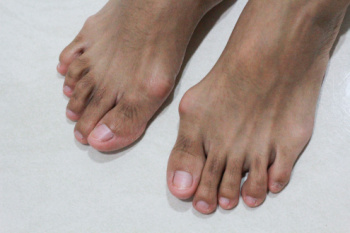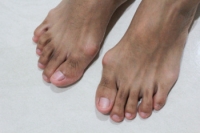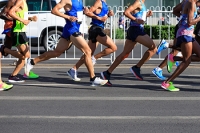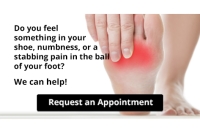
Blog (817)
Effective Foot Stretches

Keeping the feet flexible and strong is essential for overall mobility and balance. One simple method is practicing toe stretches by gently pulling the toes upward and downward to loosen tight muscles. Improving toe flexibility further enhances foot strength and reduces the risk of injury. A foot massage stretch, where you knead and press into the soles, helps to release tension and promote blood flow. Using a tennis ball to stretch the plantar fascia is another effective technique. This is done by rolling the ball under the foot as it targets deep tissue, which eases discomfort. Additionally, walking barefoot on safe, natural surfaces like grass or sand encourages the feet to move naturally, strengthening muscles and improving balance. If foot pain arises, it is suggested that you contact a podiatrist who can treat various foot conditions, and guide you on effective foot stretches.
Stretching the feet is a great way to prevent injuries. If you have any concerns with your feet consult with Dr. Kenneth Donovan from Advanced Care Foot and Ankle. Our doctor will assess your condition and provide you with quality foot and ankle treatment.
Stretching the Feet
Being the backbone of the body, the feet carry your entire weight and can easily become overexerted, causing cramps and pain. As with any body part, stretching your feet can serve many benefits. From increasing flexibility to even providing some pain relief, be sure to give your feet a stretch from time to time. This is especially important for athletes or anyone performing aerobic exercises, but anyone experiencing foot pain or is on their feet constantly should also engage in this practice.
Great ways to stretch your feet:
- Crossing one leg over the others and carefully pull your toes back. Do 10-20 repetitions and repeat the process for each foot
- Face a wall with your arms out and hands flat against the wall. Step back with one foot and keep it flat on the floor while moving the other leg forward. Lean towards the wall until you feel a stretch. Hold for 30 seconds and perform 10 repetitions for each foot
- Be sure not to overextend or push your limbs too hard or you could risk pulling or straining your muscle
Individuals who tend to their feet by regular stretching every day should be able to minimize foot pain and prevent new problems from arising.
If you have any questions, please feel free to contact one of our offices located in Warren, Livingston, and Toms River, NJ . We offer the newest diagnostic and treatment technologies for all your foot care needs.
Heel Pain Can Be Treated!
Treating Problematic Ingrown Toenails

When ingrown toenails do not respond to basic care or become painful and infected, a podiatrist can provide effective medical treatment. In less severe cases, the ingrown section of the toenail can be carefully removed during a minor procedure called partial nail avulsion, which reduces pressure and allows the area to heal. For patients with recurring ingrown toenails, a podiatrist may recommend a matrixectomy, a surgical technique that removes the nail root in the affected area to prevent regrowth. If infection is present, antibiotics may also be prescribed to reduce swelling and stop the spread of bacteria. In some situations, total nail removal may be required, particularly when the toenail is deeply curved or repeatedly causes pain. Such ingrown toenail procedures are typically performed using local anesthesia to ensure patient comfort. After surgery, patients are advised to keep the area clean and dry and avoid wearing tight footwear to support healing. If you have problematic ingrown toenails, it is suggested that you schedule an appointment with a podiatrist for a diagnosis and appropriate treatment.
Ingrown toenails can become painful if they are not treated properly. For more information about ingrown toenails, contact Dr. Kenneth Donovan of Advanced Care Foot and Ankle. Our doctor can provide the care you need to keep you pain-free and on your feet.
Ingrown Toenails
Ingrown toenails occur when a toenail grows sideways into the bed of the nail, causing pain, swelling, and possibly infection.
Causes
- Bacterial infections
- Improper nail cutting such as cutting it too short or not straight across
- Trauma to the toe, such as stubbing, which causes the nail to grow back irregularly
- Ill-fitting shoes that bunch the toes too close together
- Genetic predisposition
Prevention
Because ingrown toenails are not something found outside of shoe-wearing cultures, going barefoot as often as possible will decrease the likeliness of developing ingrown toenails. Wearing proper fitting shoes and using proper cutting techniques will also help decrease your risk of developing ingrown toenails.
Treatment
Ingrown toenails are a very treatable foot condition. In minor cases, soaking the affected area in salt or antibacterial soaps will not only help with the ingrown nail itself, but also help prevent any infections from occurring. In more severe cases, surgery is an option. In either case, speaking to your podiatrist about this condition will help you get a better understanding of specific treatment options that are right for you.
If you have any questions please feel free to contact one of our offices located in Warren, Livingston, and Toms River, NJ . We offer the newest diagnostic and treatment technologies for all your foot and ankle needs.
Causes of Foot and Ankle Pain in Teens

Foot and ankle pain in teens can result from a variety of causes, often related to growth, physical activity, or underlying conditions. Active teens may experience pain due to overuse injuries from sports or exercise, including stress fractures, tendonitis, or sprains. Growth spurts can lead to conditions like Sever’s disease, where the heel’s growth plate becomes irritated. Wearing improper footwear or lack of support can contribute to arch pain or heel discomfort. Flat feet, high arches, or biomechanical imbalances may also cause strain on joints and soft tissues. In some cases, pain may stem from inflammatory conditions or infections. If your teenager has foot pain, it is suggested that you schedule an appointment with a podiatrist who can determine what the cause is, and offer appropriate treatment solutions.
Foot Pain
Foot pain can be extremely painful and debilitating. If you have a foot pain, consult with Dr. Kenneth Donovan from Advanced Care Foot and Ankle. Our doctor will assess your condition and provide you with quality foot and ankle treatment.
Causes
Foot pain is a very broad condition that could be caused by one or more ailments. The most common include:
- Bunions
- Hammertoes
- Plantar Fasciitis
- Bone Spurs
- Corns
- Tarsal Tunnel Syndrome
- Ingrown Toenails
- Arthritis (such as Gout, Rheumatoid, and Osteoarthritis)
- Flat Feet
- Injury (from stress fractures, broken toe, foot, ankle, Achilles tendon ruptures, and sprains)
- And more
Diagnosis
To figure out the cause of foot pain, podiatrists utilize several different methods. This can range from simple visual inspections and sensation tests to X-rays and MRI scans. Prior medical history, family medical history, and any recent physical traumatic events will all be taken into consideration for a proper diagnosis.
Treatment
Treatment depends upon the cause of the foot pain. Whether it is resting, staying off the foot, or having surgery; podiatrists have a number of treatment options available for foot pain.
If you have any questions, please feel free to contact one of our offices located in Warren, Livingston, and Toms River, NJ . We offer the newest diagnostic and treatment technologies for all your foot care needs.
That Ankle Pain May Be Caused by Gout

Gout is a painful type of arthritis that can affect the ankle, not just the big toe. It develops when uric acid builds up in the body and forms sharp crystals in the joints. When this occurs in the ankle, it may cause sudden, sharp pain along with swelling, redness, and warmth in the area. Movements like walking or climbing stairs can become difficult during a flare-up. Gout flare-ups in the ankle may last for several days and often return over time, if not properly managed. Risk factors include a diet high in red or organ meats, alcohol consumption, sugary beverages, excess body weight, and high blood pressure. A podiatrist can help determine whether gout is the cause of your ankle pain by examining the foot and ordering diagnostic tests, including bloodwork or imaging. Once diagnosed, a podiatrist can recommend treatment that may include medication to lower uric acid levels and reduce inflammation. If you are experiencing sharp pain in your ankles, it is suggested that you schedule an appointment with a podiatrist for an exam to determine if gout is the cause.
Gout is a painful condition that can be treated. If you are seeking treatment, contact Dr. Kenneth Donovan from Advanced Care Foot and Ankle. Our doctor will treat your foot and ankle needs.
What Is Gout?
Gout is a form of arthritis that is characterized by sudden, severe attacks of pain, redness, and tenderness in the joints. The condition usually affects the joint at the base of the big toe. A gout attack can occur at any random time, such as the middle of the night while you are asleep.
Symptoms
- Intense Joint Pain - Usually around the large joint of your big toe, and it most severe within the first four to twelve hours
- Lingering Discomfort - Joint discomfort may last from a few days to a few weeks
- Inflammation and Redness -Affected joints may become swollen, tender, warm and red
- Limited Range of Motion - May experience a decrease in joint mobility
Risk Factors
- Genetics - If family members have gout, you’re more likely to have it
- Medications - Diuretic medications can raise uric acid levels
- Gender/Age - Gout is more common in men until the age of 60. It is believed that estrogen protects women until that point
- Diet - Eating red meat and shellfish increases your risk
- Alcohol - Having more than two alcoholic drinks per day increases your risk
- Obesity - Obese people are at a higher risk for gout
Prior to visiting your podiatrist to receive treatment for gout, there are a few things you should do beforehand. If you have gout you should write down your symptoms--including when they started and how often you experience them, important medical information you may have, and any questions you may have. Writing down these three things will help your podiatrist in assessing your specific situation so that he or she may provide the best route of treatment for you.
If you have any questions, please feel free to contact one of our offices located in Warren, Livingston, and Toms River, NJ . We offer the newest diagnostic and treatment technologies for all your foot care needs.
Reminder: When Was the Last Time...?
Causes and Common Locations of Seed Corns

Seed corns are small, hardened areas of skin that develop on the feet due to repeated friction and pressure. They appear as tiny, round calluses with a central core and often form on weight-bearing areas. These corns commonly develop on the ball of the foot, the bottom of the heel, or the sides of the toes. Causes include wearing tight or ill-fitting shoes, excessive walking or running, and dry skin that lacks natural protection. Unlike larger corns, seed corns can be tender and may cause discomfort when pressure is applied. Keeping the feet moisturized, wearing well-fitted shoes, and using protective padding can help prevent their formation. Seed corns can be painful, and may cause difficulty in completing daily activities. If you have corns on your feet, it is suggested that you visit a podiatrist who can offer effective relief and treatment solutions.
If you have any concerns regarding your feet and ankles, contact Dr. Kenneth Donovan of Advanced Care Foot and Ankle. Our doctor will treat your foot and ankle needs.
Corns: What Are They? and How Do You Get Rid of Them?
Corns can be described as areas of the skin that have thickened to the point of becoming painful or irritating. They are often layers and layers of the skin that have become dry and rough, and are normally smaller than calluses.
Ways to Prevent Corns
There are many ways to get rid of painful corns such as wearing:
- Well-fitting socks
- Comfortable shoes that are not tight around your foot
- Shoes that offer support
Treating Corns
Treatment of corns involves removing the dead skin that has built up in the specific area of the foot. Consult with Our doctor to determine the best treatment option for your case of corns.
If you have any questions please feel free to contact one of our offices located in Warren, Livingston, and Toms River, NJ . We offer the newest diagnostic and treatment technologies for all your foot and ankle needs.
Facts About Bunions

A bunion, or hallux valgus, is a bony bump that forms at the base of the big toe. A bunion develops gradually as the big toe shifts inward toward the smaller toes and places stress on the joint. Because this joint supports a significant amount of weight while walking or standing, people with bunions often experience pain, swelling, and redness in the affected area. In some cases, calluses may form where the toes rub together. Over time, bunions can worsen, making it uncomfortable to wear regular shoes or walk without discomfort. While they are most commonly seen in adults, some children are born with bunions or develop them in adolescence. Factors such as inherited foot structure, joint deformities, and certain inflammatory conditions may contribute to bunion formation. Wearing tight or narrow shoes may not directly cause bunions, but they can aggravate existing ones. A podiatrist can assess the severity of a bunion and recommend treatment, such as supportive footwear, orthotics, or surgery if needed. If you have a bunion that is causing pain, it is suggested that you schedule an appointment with a podiatrist for an exam and appropriate treatment.
If you are suffering from bunion pain, contact Dr. Kenneth Donovan of Advanced Care Foot and Ankle. Our doctor can provide the care you need to keep you pain-free and on your feet.
What Is a Bunion?
Bunions are painful bony bumps that usually develop on the inside of the foot at the joint of the big toe. As the deformity increases over time, it may become painful to walk and wear shoes. Women are more likely to exacerbate existing bunions since they often wear tight, narrow shoes that shift their toes together. Bunion pain can be relieved by wearing wider shoes with enough room for the toes.
Causes
- Genetics – some people inherit feet that are more prone to bunion development
- Inflammatory Conditions - rheumatoid arthritis and polio may cause bunion development
Symptoms
- Redness and inflammation
- Pain and tenderness
- Callus or corns on the bump
- Restricted motion in the big toe
In order to diagnose your bunion, your podiatrist may ask about your medical history, symptoms, and general health. Your doctor might also order an x-ray to take a closer look at your feet. Nonsurgical treatment options include orthotics, padding, icing, changes in footwear, and medication. If nonsurgical treatments don’t alleviate your bunion pain, surgery may be necessary.
If you have any questions, please feel free to contact one of our offices located in Warren, Livingston, and Toms River, NJ . We offer the newest diagnostic and treatment technologies for all your foot care needs.
Factors to Consider When Choosing Running Shoes

Choosing the right running shoes is important for foot health and injury prevention. Proper arch support helps distribute pressure evenly, reducing strain on the heels and forefoot. Cushioning is necessary to absorb impact, lessening stress on the joints and soft tissues. The fit of your running shoes should be secure, but not too tight to avoid blisters, black toenails, and nerve compression. Toe box width is another factor, as shoes that are too narrow can cause pain and deformities over time. The shoe’s flexibility should match natural foot movement to prevent unnecessary strain on the toes and ankles. Stability is essential, as inadequate support can increase the risk of sprains or tendon injuries. The type of running surface also matters, as road and trail shoes provide different levels of traction and shock absorption. A podiatrist can assess your foot structure and gait to recommend shoes that improve comfort and help prevent running-related injuries. If you have foot pain or other ailments caused by running, it is suggested that you schedule an appointment with a podiatrist for an exam, diagnosis, and treatment options.
If you are a runner, wearing the right running shoe is essential. For more information, contact Dr. Kenneth Donovan from Advanced Care Foot and Ankle. Our doctor can provide the care you need to keep you pain-free and on your feet.
Choosing the Right Running Shoe for Your Foot Type
To increase performance and avoid the risk of injury, it is important to choose the right running shoe based on your foot type. The general design of running shoes revolves around pronation, which is how the ankle rolls from outside to inside when the foot strikes the ground.
- Neutral runners are able to choose from a wide variety of shoes, including minimalist shoes or even going barefoot.
- Runners who overpronate, or experience an over-abundance of ankle rolling, should choose shoes that provide extra motion control and stability.
- Runners who underpronate, or supinate, have feet that have high arches and lack flexibility, preventing shock absorption. They require shoes with more flexibility and cushion.
If you have any questions please feel free to contact one of our offices located in Warren, Livingston, and Toms River, NJ . We offer the newest diagnostic and treatment technologies for all your foot and ankle needs.













